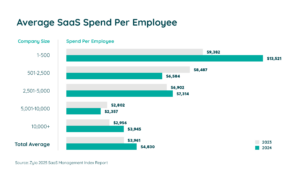
Zoom License Cost 2026: Which Plan Offers the Best Value for Your…
Table of Contents ToggleConsumerization of Enterprise SaaS Benefits the End UserInvolve...
Back
Back
Search for Keywords...
Blog

Table of Contents
The importance of SaaS vendor management is growing. In fact, today, enterprise SaaS spend represent an average of $4,830 per employee per year. To gain some insights surrounding this growing category, I sat down with Mike D. Kail, CTO of Everest, and discussed common challenges and opportunities.

SaaS use is expanding. Gartner projects a nearly 19% growth in the category this year alone. And the consumerization of enterprise SaaS applications spurs that growth.
Many SaaS products design software focusing on the end user first. With an emphasis on end-user experience, software applications have become easier to implement and use. Consequently, business units are adopting and utilizing SaaS at higher rates.
Additionally, enterprise cloud-based subscription software boasts the rapid deployment of updates and new product features. Compared to traditional on-premises software update deployments, IT teams no longer manage burdensome semi-annual updates that disrupt the business.
Frequent application updates, informed by user sentiment and behavior, provide increasing value from the enterprise software purchase. As a result, more IT and business leaders are moving to cloud-based software.
Today, SaaS vendors and enterprise technology managers prioritize the end users. IT teams can no longer afford to select applications and force adoption. IT leaders must factor user experience and satisfaction into decision-making for the acquisition and long-term management of SaaS subscriptions.
Understanding how the user experience affects adoption and utilization can prevent the growth of shadow IT by providing users the tools they’re more likely to continue to utilize. With the plethora of easily accessible SaaS choices, users dissatisfied with a software experience often acquire tools on their own. This rogue SaaS acquisition inevitably leads to the growth of shadow IT.
Enterprise SaaS pricing should be forecastable and well defined. Many SaaS tools for the enterprise begin with a basic price, such as a basic subscription or license fee. But many also include variable costs based on consumption metrics. Examples include maximum storage thresholds for data or content storage services like Box and Dropbox or contact list count maximums for customer relationship management tools such as Salesforce.
Having a forecastable price includes defining and documenting the consumption metric, but also monitoring usage to ensure there are no surprises if and when a threshold is crossed and additional costs are incurred. Without direct and continuous measurement, either through the SaaS application directly or via tools like Zylo’s SaaS management platform, CIOs and technology managers risk costly surprises when the true-up occurs.
When purchasing a new SaaS tool, it’s important to be aware of how exactly it will integrate into your current technology environment. Enterprise SaaS especially advertises the cost advantage of economies of scale as the tool deploys to a greater number of users or transactions.
Will the application require a third-party manager or implementation specialist to integrate the new SaaS tool into your existing software stack? If so, the savings produced by scaling can sometimes be negligible when weighed against the cost of hiring to implement.
Getting answers from SaaS vendors to key questions about the process and costs associated with integrating, adopting, or on-boarding the new tools is an essential step.
When enterprise SaaS vendors circumvent procurement processes and sell directly to teams or users, shadow IT proliferates. However, decentralized software acquisition can cause wasted spend and administrative burden.
In an enterprise environment, the symptoms of leads to:
By approaching SaaS acquisition in partnership with IT and procurement and choosing tools that can bring value to the entire organization, teams avoid creating silos and the “pirate ship” mentality.
Enterprise software decisions about what software to buy can no longer occur in complete isolation. The modern enterprise technology leader holds responsibility for filling the gap between what the user wants and needs, what the vendor offers, and how to square the difference when implementing the technology into the existing organization.
This requires creating continuous feedback loops where user experience and inputs influence the decision-making. Many modern tech leaders accomplish this task via the creation of user feedback groups, surveys, and other feedback tools, or by applying the principles of “management by walking around,” a.k.a speaking and listening to user concerns directly in a transparent way.
These learnings can then be applied to SaaS vendor relationships to influence acquisition decisions and renewal road amps.
Enterprise SaaS vendor management is a practical art still not yet fully matured. However, many principles of enterprise leadership apply to this relatively new practice. Technology leaders who focus on the needs of the user, who keep maintaining value for the organization as a top priority, and who lead through partnership are the most likely to be successful in the effort.
To learn about how Zylo helps technology leaders discover, manage, measure and govern SaaS applications in enterprise organizations, schedule a demo today.

Table of Contents ToggleConsumerization of Enterprise SaaS Benefits the End UserInvolve...

Table of Contents ToggleConsumerization of Enterprise SaaS Benefits the End UserInvolve...

Table of Contents ToggleKey Themes That Shaped SaaS Management in 20251....

Table of Contents ToggleConsumerization of Enterprise SaaS Benefits the End UserInvolve...
| Cookie | Duration | Description |
|---|---|---|
| cookielawinfo-checkbox-analytics | 11 months | This cookie is set by GDPR Cookie Consent plugin. The cookie is used to store the user consent for the cookies in the category "Analytics". |
| cookielawinfo-checkbox-functional | 11 months | The cookie is set by GDPR cookie consent to record the user consent for the cookies in the category "Functional". |
| cookielawinfo-checkbox-necessary | 11 months | This cookie is set by GDPR Cookie Consent plugin. The cookies is used to store the user consent for the cookies in the category "Necessary". |
| cookielawinfo-checkbox-others | 11 months | This cookie is set by GDPR Cookie Consent plugin. The cookie is used to store the user consent for the cookies in the category "Other. |
| cookielawinfo-checkbox-performance | 11 months | This cookie is set by GDPR Cookie Consent plugin. The cookie is used to store the user consent for the cookies in the category "Performance". |
| viewed_cookie_policy | 11 months | The cookie is set by the GDPR Cookie Consent plugin and is used to store whether or not user has consented to the use of cookies. It does not store any personal data. |
